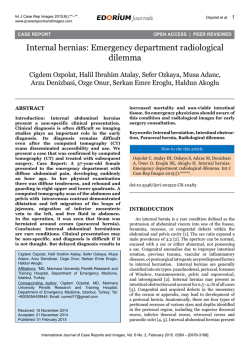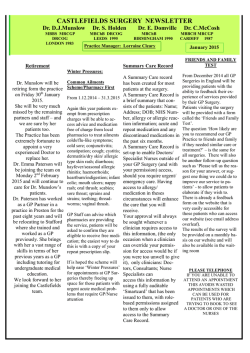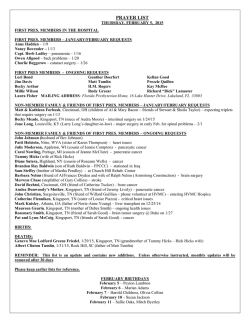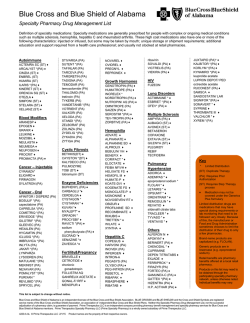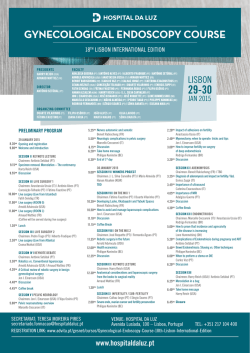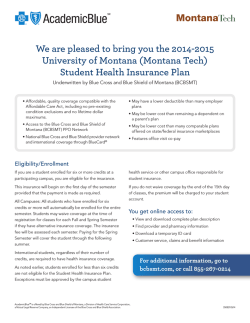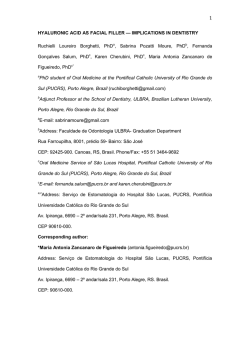
Management of Excessive Skin and Subcutaneous Tissue
Name of Policy: Management of Excessive Skin and Subcutaneous Tissue Policy #: 058 Category: Surgery Latest Review Date: January 2015 Policy Grade: D Background/Definitions: As a general rule, benefits are payable under Blue Cross and Blue Shield of Alabama health plans only in cases of medical necessity and only if services or supplies are not investigational, provided the customer group contracts have such coverage. The following Association Technology Evaluation Criteria must be met for a service/supply to be considered for coverage: 1. The technology must have final approval from the appropriate government regulatory bodies; 2. The scientific evidence must permit conclusions concerning the effect of the technology on health outcomes; 3. The technology must improve the net health outcome; 4. The technology must be as beneficial as any established alternatives; 5. The improvement must be attainable outside the investigational setting. Medical Necessity means that health care services (e.g., procedures, treatments, supplies, devices, equipment, facilities or drugs) that a physician, exercising prudent clinical judgment, would provide to a patient for the purpose of preventing, evaluating, diagnosing or treating an illness, injury or disease or its symptoms, and that are: 1. In accordance with generally accepted standards of medical practice; and 2. Clinically appropriate in terms of type, frequency, extent, site and duration and considered effective for the patient’s illness, injury or disease; and 3. Not primarily for the convenience of the patient, physician or other health care provider; and 4. Not more costly than an alternative service or sequence of services at least as likely to produce equivalent therapeutic or diagnostic results as to the diagnosis or treatment of that patient’s illness, injury or disease. Page 1 of 9 Proprietary Information of Blue Cross and Blue Shield of Alabama Medical Policy #058 Description of Procedure or Service: Abdominoplasty is a surgical procedure performed to tighten a lax abdominal wall caused by diastasis recti (the separation of the two rectus muscles along the medial line of the abdominal wall) and removes excess fat and abdominal skin. Abdominoplasty is more commonly known as a “tummy tuck”. This recontouring of the abdominal wall area is often performed solely to improve the appearance of a protuberant abdomen by creating a flatter, firmer abdomen. Abdominoplasty is always considered cosmetic as it is not performed for functional improvements. Panniculectomy is the surgical removal of the overhanging “apron” of redundant skin and fat in the lower abdominal area. Panniculectomy is different from abdominoplasty, in that abdominoplasty tightens the muscle as well as removes excess skin and fat, but a panniculectomy is performed only to remove excess skin and fat. A panniculus is often seen in individuals who have had significant weight loss or in those who are morbidly obese. The panniculus can cause difficulty fitting into clothing, interference with personal hygiene, impaired ambulation and be associated with lower back pain or pain in the panniculus itself. The redundant skin folds are predisposed to areas of intertrigo, which can give rise to infections of the skin (fungal dermatitis, folliculitis, subcutaneous abscesses) or panniculitis. Lipectomy is a surgical technique that is used to cut and remove unwanted fat deposits from specific areas of the body. These include: chin, neck, upper arms, above the breasts, abdomen, buttocks, hips, thighs, knees, calves and ankles. It may also be performed in conjunction to further sculpt the abdomen or remove fat from other areas. These are generally considered to be cosmetic procedures. Policy: Excision of excessive skin and subcutaneous tissue of the following areas does not meet Blue Cross and Blue Shield of Alabama’s medical criteria for coverage: • • • Thigh, leg, hip, buttock, arm, forearm or hand, submental fat pad, Females- labia minora reduction, labia major reshaping, clitoral reduction, hymenoplasty, pubic liposuction, vaginal rejuvenation or tightening Males- phalloplasty, scrotoplasty Panniculectomy of the abdomen meets Blue Cross and Blue Shield of Alabama’s medical criteria for coverage when all of the following conditions are met: • • • The panniculus fold(s) hangs below the level of the pubis with photo documentation; AND Clinical records and photos document the presence of symptomatology such as chronic intertrigo, excoriation, infection, etc., for which 3 months of conservative treatment has been tried; AND There is difficulty with the activities of daily living, such as ambulation, and personal hygiene Page 2 of 9 Proprietary Information of Blue Cross and Blue Shield of Alabama Medical Policy #058 Panniculectomy does not meet Blue Cross and Blue Shield of Alabama’s medical criteria for coverage when the following conditions exist: • As an adjunct to other medically necessary procedures, including but not limited to hysterectomy; unless the medical criteria is met • For the treatment of back pain • For the purpose of improving appearance (cosmetic) • For improving abdominal wall laxity (tummy tuck, cosmetic) or diastasis recti • For the treatment of psychological or psychosocial complaints • Suction-assisted lipectomy when performed as the only procedure Abdominoplasty, a surgical procedure that tightens a lax abdominal wall muscle and removes excess fat and abdominal skin, does not meet Blue Cross and Blue Shield of Alabama’s medical criteria for coverage as this is considered cosmetic and not functional. (See Key Points) Lipectomy, a surgical technique used to cut and remove subcutaneous fatty tissue, does not meet Blue Cross and Blue Shield of Alabama’s medical criteria for coverage as this is considered cosmetic. Blue Cross and Blue Shield of Alabama does not approve or deny procedures, services, testing, or equipment for our members. Our decisions concern coverage only. The decision of whether or not to have a certain test, treatment or procedure is one made between the physician and his/her patient. Blue Cross and Blue Shield of Alabama administers benefits based on the members' contract and corporate medical policies. Physicians should always exercise their best medical judgment in providing the care they feel is most appropriate for their patients. Needed care should not be delayed or refused because of a coverage determination. Key Points: Abdomen Abdominoplasty is considered reconstructive when performed to correct or relieve structural defects of the abdominal wall and/or chronic low back pain due to functional incompetence of the anterior abdominal wall. These conditions may be caused by: Permanent over stretching of the anterior abdominal wall following one or more pregnancies; Permanent over stretching (with or without diastasis recti of the anterior abdominal wall with a large or long abdominal panniculus) following weight loss in the treatment of morbid obesity and resulting in the uncontrollable intertrigo and/or difficult ambulation and interference with personal hygiene; Trauma or surgery to the anterior wall of the abdomen resulting in loss of fascial integrity or pain from scar contracture; Abdominal hernia following previous abdominal surgery. When an abdominoplasty is performed solely to enhance a patient’s appearance in the absence of any signs or symptoms of functional abnormalities, the procedure should be considered cosmetic in nature. The current medical evidence addressing the efficacy of panniculectomy consists mostly of individual case reports and review articles. The evidence base includes a limited number of Page 3 of 9 Proprietary Information of Blue Cross and Blue Shield of Alabama Medical Policy #058 small- controlled trials. . However, there is adequate clinical opinion to support the use of this procedure in some circumstances where an individual's health is compromised. Early studies by Matory (1994) and Vastine (1999) demonstrated a direct relationship between BMI and operative risk with abdominal surgery and abdominoplasty in obese individuals. In a retrospective cohort series of individuals who underwent post-bariatric panniculectomy (n=126), the only factor that independently predicted postoperative complications after panniculectomy was pre-panniculectomy BMI (Arthurs, 2007). Those with a BMI greater than 25 kg/m2 were at nearly three times the risk of postoperative wound complications. Although those who experienced a plateau in weight loss at a BMI of 30-35 kg/m2 did have the largest functional improvement from a panniculectomy, they also experienced the highest risk postoperatively. The average weight loss following bariatric surgery prior to panniculectomy was 116 ± 35 lbs. A limitation of this study is its retrospective design and small sample population. Acarturk (2004) compared the surgical outcomes of panniculectomy following bariatric surgery in another retrospective series of 123 participants (mean age 44.5 years). The outcomes of 21 participants with panniculectomy performed at the time of bariatric surgery were compared with the surgical outcomes of 102 participants who waited 17 ± 11 months to undergo panniculectomy. Overall, individuals who had panniculectomy simultaneously with bariatric surgery experienced more complications. Wound infections were 48% versus 16%; wound dehiscence 33% versus 13%; and there was a higher incidence (24% versus 0 %) of postoperative respiratory distress in individuals with the combined procedures. There were three postoperative deaths in the combined procedure cohort and none in the group that delayed panniculectomy until an average weight loss of 126 ± 59 lbs was achieved. The authors concluded that an initial period of substantial weight loss prior to the procedure results in a safer and more effective panniculectomy procedure. The American Society of Plastic Surgeons (ASPS) Practice Parameter for Surgical Treatment of Skin Redundancy for Obese and Massive Weight Loss Patients (2007b) recommends that body contouring surgery, including panniculectomy, be performed only after an individual maintains a stable weight for two to six months. For individuals who are post -bariatric surgery, this is reported to occur 12 to 18 months after surgery when the BMI has reached the 25 kg/m2 to 30 kg/m2 range (Rubin, 2004). If performed prematurely, a potential exists for a second panniculus to develop once additional weight loss has occurred and the risks of postoperative complications are increased. Weight loss and BMI are important when considering panniculectomy and a significant amount of weight loss may not bring the BMI of an individual to less than 30 kg/m2; however a panniculectomy may still be necessary (Arthurs, 2007). The American Society for Metabolic and Bariatric Surgery Consensus statement states weight loss can vary from about 25% to 70% of an individual's excess body weight depending on the type of bariatric surgery that is performed (Buchwald, 2005). Evidence is insufficient to support panniculectomy as a medically beneficial procedure when the above medically necessary criteria are not met. This includes the concurrent use of panniculectomy with other abdominal surgical procedures, such as incisional or ventral hernia repair, or hysterectomy, unless the criteria for panniculectomy alone are met. Although it has been suggested that the presence of a large overhanging panniculus may interfere with the Page 4 of 9 Proprietary Information of Blue Cross and Blue Shield of Alabama Medical Policy #058 surgery or compromise post-operative recovery, there is insufficient evidence to support the proposed benefits of improved surgical site access or improved health outcomes. A study by Zemlyak and colleagues (2012) reported on a retrospective review of individuals who had panniculectomy alone versus individuals who had panniculectomy and simultaneous ventral hernia repair. There were 143 participants in the panniculectomy/ventral hernia repair group and 42 participants in the panniculectomy group. The rates for incisional complications and interventions between the two groups were not statistically significant. However, after controlling for age, gender, BMI, subcutaneous use of talc, and intraoperative pulse-a-vac irrigation in the multivariate regression analysis, the group that had both panniculectomy and ventral hernia repair was more likely to develop wound cellulitis. The authors note that while panniculectomy with ventral hernia repair reduces the stress on the hernia repair and potentially decreases the recurrence rate, this potential advantage remains to be proven in large comparative studies. Fischer and colleagues conducted a large retrospective database analysis to assess the additional risk of ventral hernia repair and panniculectomy compared with hernia repair alone (n=55,537). The study authors found that individuals who underwent the combined procedure were significantly at risk for wound complications (P<0.001); venous thromboembolism (P=0.044); reoperation (P<0.001); and overall medical morbidity (P<0.001). There is little evidence to demonstrate significant health benefit imparted by abdominoplasty either for diastasis recti or for other indications. While there is ample literature to illustrate the cosmetic benefits of this procedure, improvements in physical functioning, cessation of back pain, and other positive health outcomes have not been demonstrated. The main body of evidence is limited to individual case reports evaluating the cosmetic outcomes of the surgery. At this time, there is insufficient evidence to support abdominoplasty for other than cosmetic purposes when done to remove excess abdominal skin or fat, with or without tightening lax anterior abdominal wall muscles (ASPS Practice Parameter, 2007b). Surgical procedures to correct diastasis recti are not effective for alleviating back pain or other non-cosmetic conditions. There is insufficient evidence to support the use of surgical procedures to correct diastasis recti for other than cosmetic purposes. The use of liposuction has not been shown in clinical trials to provide additional benefits beyond standard surgical techniques and has been associated with significant complications, including death. Non-abdomen Brachioplasty is a surgical procedure used to remove excess fat and skin from the back of the upper arm. This procedure is primarily to improve a patient’s appearance. Buttock and thigh lifts are surgical procedures used to remove excess fat and skin from the buttocks and thighs. These procedures are intended to enhance the appearance and have no known medical benefits even if done following significant weight loss. Page 5 of 9 Proprietary Information of Blue Cross and Blue Shield of Alabama Medical Policy #058 A wide variety of procedures have been proposed to alter the appearance, size, or function of the external and internal female genitalia. Surgical procedures to alter the size or shape of the labia or clitoris restore the hymen, and other such measures do not provide any physical health benefits. The labia minora is part of the external structure of the vagina. In some patients the labia minora may be enlarged or asymmetrical leading to mild discomfort with wearing certain clothing or during some activities. Reconstructive surgical procedures have been proposed to reduce enlarged labia minora. These procedures have not been well studied in the medical literature and the possible risks have not been adequately assessed in relation to the potential benefits. Phalloplasty is a surgical procedure to reconstruct or enlarge the penis. Reconstruction may be required in cases of traumatic injury or loss due to disease. Enlargement may be desired in cases of abnormally small penis size. Key Words: Abdominoplasty, panniculectomy, lipectomy, thighplasty, tummy tuck brachioplasty, panniculus, hip-plasty, labial reduction, phalloplasty, scrotoplasty Approved by Governing Bodies: Not applicable Benefit Application: Coverage is subject to member’s specific benefits. Group specific policy will supersede this policy when applicable. ITS: Home Policy provisions apply FEP contracts: Special benefit consideration may apply. Refer to member’s benefit plan. Coding: 15830 15832 15833 15834 15835 15836 Excision, excessive skin and subcutaneous tissue (including lipectomy); abdomen (infraumbilical panniculectomy) Excision, excessive skin and subcutaneous tissue (including lipectomy); thigh Excision, excessive skin and subcutaneous tissue (including lipectomy); leg Excision, excessive skin and subcutaneous tissue (including lipectomy); hip Excision, excessive skin and subcutaneous tissue (including lipectomy); buttock Excision, excessive skin and subcutaneous tissue (including lipectomy); arm Page 6 of 9 Proprietary Information of Blue Cross and Blue Shield of Alabama Medical Policy #058 15837 15838 15839 15847 17999 55175 55180 Excision, excessive skin and subcutaneous tissue (including lipectomy); forearm or hand Excision, excessive skin and subcutaneous tissue (including lipectomy); submental fat pad Excision, excessive skin and subcutaneous tissue (including lipectomy); other area Excision, excessive skin and subcutaneous tissue (includes lipectomy), abdomen (e.g., abdominoplasty) (includes umbilical transposition and fascial plication) (list separately in addition to code for primary procedure) Unlisted procedure, skin, mucous membrane and subcutaneous tissue Scrotoplasty; simple Scrotoplasty; complicated References: 1. Acarturk TO, Wachtman G, Heil B, et al. Panniculectomy as an adjuvant to bariatric surgery. Ann Plast Surg. 2004; 53(4):360-366. 2. American Society of Plastic Surgeons. Abdominoplasty. www.plasticsurgery.org/Documents/medical-professionals/health-policy/evidencepractice/AbdominoplastyAndPanniculectomy.pdf 3. American Society of Plastic Surgeons. Treatment of skin redundancy following massive weight loss. www.plasticsurgery.org/Documents/medical-professionals/healthpolicy/evidence-practice/Surgical-Treatment-of-Skin-Redundancy-Following-MassiveWeight-Loss.pdf. 4. Arthurs ZM, Cuadrado D, Sohn V, et al. Post-bariatric panniculectomy: pre-panniculectomy body mass index impacts the complication profile. Am J Surg. 2007; 193(5):567-570. 5. Blomfield PI, Le T, Allen DG, Planner RS. Panniculectomy: a useful technique for the obese patient undergoing gynecological surgery. Gynecol Oncol. 1998; 70(1):80-86. 6. Brown M, Adenuga P, Soltanian H. Massive Panniculectomy in the Super Obese and SuperSuper Obese: Retrospective Comparison of Primary Closure versus Partial Open Wound Management. Past Reconstr Surg. 2014 Jan; 133(1):32-9. 7. Cassar K, Munro A. Surgical treatment of incisional hernia. Br J Surg. 2002; 89(5):534-545. 8. Evans C, Debord J, Howe H, et al. Massive panniculectomy results in improved functional outcome. Am J Surg. 2014 Mar; 207(3):441-4. 9. Fischer JP, Tuggle CT, Wes AM, Lovach SJ. Concurrent panniculectomy with open ventral hernia repair has added risk versus ventral hernia repair: an analysis of the ACS-NSQIP database. J Plast Recontr Aesthet Surg. 2014; 67(5):693-701. 10. Hopkins MP, Shriner AM, Parker MG, Scott L. Panniculectomy at the time of gynecologic surgery in morbidly obese patients. Am J Obstet Gynecol. 2000; 182(6):1502-1505. 11. Hughes KC. Ventral hernia repair with simultaneous panniculectomy. Ann Surg. 1996; 62(8):678-681. 12. Matarasso A, Wallach SG, Rankin M, Galiano RD. Secondary abdominal contour surgery: a review of early and late reoperative surgery. Plast Reconstr Surg. 2005; 115(2):627-632. Page 7 of 9 Proprietary Information of Blue Cross and Blue Shield of Alabama Medical Policy #058 13. Matory WE, O'Sullivan J, Fudem G, Dunn R. Abdominal surgery in patients with severe morbid obesity. Plast Reconstr Surg 1994; 94(7):976-987. 14. Nahas FX, Augusto SM, Ghelfond C. Should diastasis recti be corrected? Aesth Plas Surg. 1997; 21(4):285-289. 15. Pearl ML, Valea FA, Disilvestro PA, Chalas E. Panniculectomy in morbidly obese gynecologic oncology patients. Int J Surg Investig. 2000; 2(1):59-64. 16. Pestana IA, Campbell D, Fearmonti RM, et al. "Supersize" panniculectomy: indications, technique, and results. Ann Plast Surg. 2014 Oct; 73(4):416-21. 17. Powell JL. Panniculectomy to facilitate gynecologic surgery in morbidly obese women. Obstet Gynecol. 1999 94(4):528-531. 18. Rubin JP, Nguyen V, Schwentker A. Perioperative management of the post-gastric-bypass patient presenting for body contour surgery. Clin Plast Surg. 2004; 31(4):601-610. 19. Staalesen T1, Elander A, Strandell A, Bergh C. A systematic review of outcomes of abdominoplasty. J Plast Surg Hand Surg. 2012 Sep; 46(3-4):139-44. 20. Tillmanns TD, Kamelle SA, Abudayyeh I, et al. Panniculectomy with simultaneous gynecologic oncology surgery. Gynecol Oncol. 2001; 83(3):518-522. 21. Vastine VL, Morgan RF, Williams GS, et al. Wound complications of abdominoplasty in obese patients. Plast Surg. 1999; 42(1):34-39. 22. Zemlyak AY, Colavita PD, El Djouzi S, et al. Comparative study of wound complications: isolated panniculectomy versus panniculectomy combined with ventral hernia repair. J Surg Res. 2012; 177(2):387-391. Policy History: Medical Policy Group, July 2002 Medical Policy Administration Committee, July 2002 Available for Comment August 26-October 9, 2002 Medical Policy Group, January 2004 Medical Policy Group, September 2005 (1) Medical Policy Administration Committee, October 2005 Available for comment October 12-November 28, 2005 Medical Policy Group, December 2006 (1) Medical Policy Administration Committee, January 2007 Available for comment January 5-February 19, 2007 Medical Policy Group, February 2009 (1) Medical Policy Group, February 2010 (1) Medical Policy Administration Committee April 2010 Available for comment April 7-May 21, 2010 Medical Policy Group, September 2010 (1): Photographic documentation was added to the policy Medical Policy Administration Committee, September 2010 Available for comment September 8-October 22, 2010 Medical Policy Group, January 2011 Medical Policy Group, July 2011 (1): Update to Description related to abdominoplasty and removal of coding; change in Policy related to removal of coverage for lipectomy and clarification of differences between abdominoplasty, panniculectomy and lipectomy Page 8 of 9 Proprietary Information of Blue Cross and Blue Shield of Alabama Medical Policy #058 Medical Policy Administration Committee, July 2011 Available for comment July 21 through September 5, 2011 Medical Policy Group, January 2013 (1): Literature review complete, no new references added; no change to policy statement Medical Policy Group, January 2015 (1): Update to Key Points and References; policy criteria prior to 11/5/2011 removed; no change to policy statement This medical policy is not an authorization, certification, explanation of benefits, or a contract. Eligibility and benefits are determined on a caseby-case basis according to the terms of the member’s plan in effect as of the date services are rendered. All medical policies are based on (i) research of current medical literature and (ii) review of common medical practices in the treatment and diagnosis of disease as of the date hereof. Physicians and other providers are solely responsible for all aspects of medical care and treatment, including the type, quality, and levels of care and treatment. This policy is intended to be used for adjudication of claims (including pre-admission certification, pre-determinations, and pre-procedure review) in Blue Cross and Blue Shield’s administration of plan contracts. Page 9 of 9 Proprietary Information of Blue Cross and Blue Shield of Alabama Medical Policy #058
© Copyright 2026


